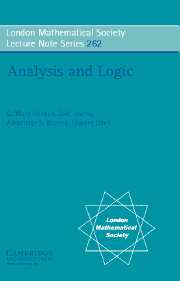Book contents
- Frontmatter
- Contents
- Preface
- Introduction
- Part One: Ultraproducts in Analysis
- Actions of Polish Groups and Classification Problems
- 1 Introduction
- 2 The General Glimm-Effros Dichotomy
- 3 Actions of Polish Groups
- 4 Actions of Countable Groups
- 5 Actions of Locally Compact Groups
- 6 Actions of the Infinite Symmetric Group
- 7 Turbulence I: Overview
- 8 Turbulence II: Basic Facts
- 9 Turbulence III: Induced Actions
- 10 Turbulence IV: Some Examples
- 11 Turbulence V: Calmness
- 12 Turbulence VI: The First Main Theorem
- 13 Turbulence VII: The Second Main Theorem
- References
- Index
- On Subspaces, Asymptotic Structure, and Distortion of Banach Spaces; Connections with Logic
1 - Introduction
Published online by Cambridge University Press: 05 May 2013
- Frontmatter
- Contents
- Preface
- Introduction
- Part One: Ultraproducts in Analysis
- Actions of Polish Groups and Classification Problems
- 1 Introduction
- 2 The General Glimm-Effros Dichotomy
- 3 Actions of Polish Groups
- 4 Actions of Countable Groups
- 5 Actions of Locally Compact Groups
- 6 Actions of the Infinite Symmetric Group
- 7 Turbulence I: Overview
- 8 Turbulence II: Basic Facts
- 9 Turbulence III: Induced Actions
- 10 Turbulence IV: Some Examples
- 11 Turbulence V: Calmness
- 12 Turbulence VI: The First Main Theorem
- 13 Turbulence VII: The Second Main Theorem
- References
- Index
- On Subspaces, Asymptotic Structure, and Distortion of Banach Spaces; Connections with Logic
Summary
We will discuss in this paper some aspects of a general program whose goal is the development of the theory of definable actions of Polish groups, the structure and classification of their orbit spaces, and the closely related study of definable equivalence relations. This work is motivated by basic foundational questions, like understanding the nature of complete classification of mathematical objects up to some notion of equivalence by invariants, and creating a mathematical framework for measuring the complexity of such classification problems. This theory, which has been growing rapidly over the last few years, is developed within the context of descriptive set theory, which provides the basic underlying concepts and methods. On the other hand, in view of the broad scope of this theory, there are natural interactions of it with other areas of mathematics, such as the theory of topological groups, topological dynamics, ergodic theory and its relationships with the theory of operator algebras, model theory, and recursion theory.
Classically, in various branches of dynamics one studies actions of the groups of integers ℤ, reals ℝ, Lie groups, or even more generally (second countable) locally compact groups. One of the goals of the theory is to expand this scope by considering the more comprehensive class of Polish groups (separable completely metrizable topological groups), which seems to be the widest class of well-behaved (for our purposes) groups and which includes practically every type of topological group we are interested in.
- Type
- Chapter
- Information
- Analysis and Logic , pp. 117 - 119Publisher: Cambridge University PressPrint publication year: 2003



